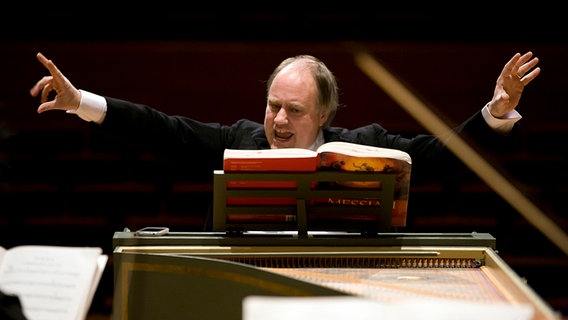Nachgefragt: John Butt

Auf dem Gebiet der historischen Aufführungspraxis für Barock und Klassik gilt das Dunedin Consort als eines der führenden Ensembles. Am 1. November 2017 können Sie sich beim Konzert der Reihe NDR Das Alte Werk in der Laeiszhalle selbst von dessen Können überzeugen. Vorab verrät der Leiter des schottischen Ensembles John Butt, was den Abend - mit vergleichsweise selten gespielten weltlichen und geistigen Werken von Johann Sebastian Bach - so besonders macht.
Sie arbeiten mit einem kleinen Ensemble. Die Chorpartien werden von einem Doppelquartett gesungen. Entspricht dies historischen Aufführungsformen bei Bach und in seinem Umkreis?
John Butt: Records from the schools in major towns in Lutheran Germany often give us quite a lot of information about how the boys were divided in order to provide the choirs in the various churches. As Michael Maul has recently established, the Thomasschule in Leipzig was relatively standard in setting the number of boys in the first, and most expert, "Cantorey" at eight (thus enabling the performance of double choir motets).
Inevitably, this number was by no means constantly maintained, and Bach may sometimes have had more or fewer (particularly when the boys had to play instruments too). Exactly how they were employed in Bach's own music is a matter of intense debate: It seems clear, that the four main singers ("Concertists") sang all the solos and everything else in their range; and, in a small number of cases, Bach provided four extra parts for the "Ripienists" to double the main singers in the choruses and chorales.
The debate is therefore specifically about whether Bach tended largely to use only the four most expert singers (through preference?) or whether he always wanted to add the four extra singers (although, if so, most of the parts do not seem to have survived).
Vordergründig sieht es bei Ihrem Programm so aus: Der erste Teil vertritt mit der Instrumentalmusik den zukunftsorientierten Bach, der zweite mit der geistlichen Vokalmusik den traditionsorientierten. Sie haben in Bachs Passionen den Dialog mit der Moderne (als zeitgeschichtlicher Strömung seit der Renaissance) entdeckt. Gilt Ähnliches auch für die "Kleinen Messen" und ihre Kantatenvorlagen?
Butt: If we see the "future" as a process of secularisation, then yes, the instrumental music points towards a future when instrumental music - for a while at least - became prized more highly than texted music. But this is surely a huge generalisation: Texted music remained important throughout most later ages of music and is still perhaps more highly prized, at least in the more popular genres of music.
With Bach's Latin mass settings, we have a rather more complex situation: Here Bach takes movements from his cantata repertoire, original designed for specific Sundays in the church year and turns them into the more ecumenical (and repeatable) genre of the Kyrie and Gloria of the Mass. This is not a specifically "modern" move, but what is interesting is how Bach reworks music (and text) from one context for another.
Parody is not in itself new, but Bach's case is especially remarkable: His music seems full of "hooks" that attach to a variety of emotional contexts. The "Gloria" movement of the A major mass, for instance, comes from a cantata where Jesus wishes peace upon his followers, specifically when they are facing their enemies. The contrasting mood of this setting then perfectly fits the joyful affect of the Gloria together with the more comforting text that follows ("et in terra pax"). What Bach seems to be intuiting here is that music is neither meaningless nor tethered to a specific meaning: It simply acts as an arresting structure of emotional nuances, one that is to a certain degree autonomous, and one that shows that provisional meaning, artificially achieved, can be as deep as eternal truths - in all, one of the most difficult but also most stimulating lessons of the modern age.
Wenn Bach eigene Kompositionen erneut verwendete, unterzog er sie in der Regel einer Revision. Wie stark griff er für die Missae breves in den ursprünglichen Notentext ein, zum Beispiel im Gloria der G-Dur-Messe?
Butt: Bach's whole method of composition was, to him, a form of revision: He learned to take existing pieces, adapt and improve them as the fundamental process of "imitatio". So he continued this process with his own pieces, changing, adapting and (almost always) somehow rendering them more complete and closer to "perfection". One particular technique was the so-called "Einbau" by which he would insert vocal parts into a preexisting ritornello or instrumental movement - this is how he wrote most of his arias and something he continues to do in the Gloria of the G Major Mass.
Bach nutzte für seine Messen Vorlagen aus sehr verschiedenen Kantaten. Diese Art der Auswahl spricht für ein phänomenales Gedächtnis des Komponisten für das, was er einmal geschrieben hatte. Weiß man darüber Genaueres?
Butt: Bach lived in the age of the first truly comprehensive encyclopedias, not only the famous French one of Diderot and d'Alembert but also that of J.H. Zedler in Leipzig. Part of the character of education and thought was to categorise and regulate information, knowledge and methods of enquiry. This mentality lies behind Bach's "Wohltemperiertem Klavier" (covering every key in turn and also exploring every possible style of prelude and fugue), but also in his desire to "regulate" church music through his annual cantata cycles. It may well be that he saw his entire compositional output as an encyclopedia of music.
Das Interview führte Habakuk Traber.
Schlagwörter zu diesem Artikel
Klassik
